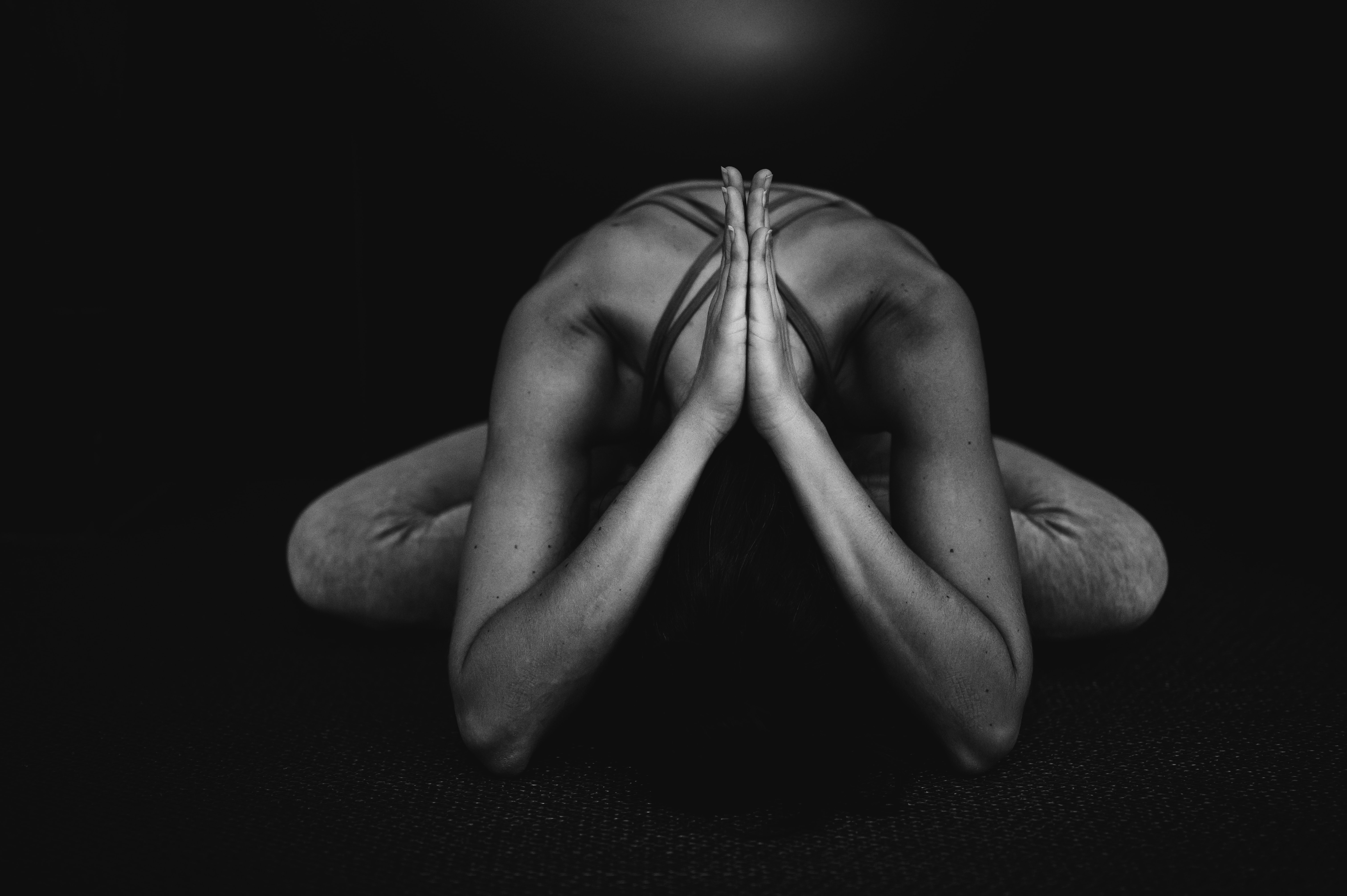CREATIVE NONFICTION
By Rachael Hanel
You’ll need strength to do this.
*
You see the bodies around you, beautiful in their power, the way legs float effortlessly up into the air and achieve sirsasana, headstand, for many breaths. You want that power and beauty, too.
*
Week after week, while others do sirsasana, you practice ardha pincha mayurasana, dolphin pose. On your knees, you form a triangle base with your forearms, fingers interlaced. Cradle the crown of your head into your hands. Lift up your hips, legs straight, heels on the mat, as you do in adho mukha svanasana, downward-facing dog. Then walk your toes toward your arms. Feel the shift as your weight moves from your feet to your shoulders. You lift one leg up, then the other. You feel too heavy to ever float.
*
You live in a small town, teach at the university, volunteer. A new friend enters your orbit. She’s friendly and funny. Everyone likes her, if Facebook is an accurate gauge.
*
Sirsasana is not what it seems. You’re not standing on your head. The effort is born out of your core and shoulders. Regular practitioners of sirsasana will push down with their shoulders and arms and lift their heads off the mat, at first just enough to slip a piece of paper underneath, but with practice there will be room for a book.
*
You spend more time with her and see beyond her façade. She’s not friendly, she’s not funny. In fact, she’s cruel and critical. According to her, you do everything wrong. You teach wrong (my dad never has any absent students, even when he teaches at 8 a.m.), you wear the wrong clothes (I have that same shirt, I wear it only for working out), you get tattoos (I hate tattoos), you go to yoga class (I hate yoga), you train for a marathon wrong (you wear a watch? I never wear a watch) you stay in and watch movies with your husband (how boring) when you could be in downtown Minneapolis partying in the club scene.
*
You do ardha pincha mayurasana for years and years. You hop one foot off the mat, then the other, just to get a feel, for the smallest fraction of time, of weightlessness.
*
You see the bodies around you, beautiful in their power, the way the legs float effortlessly up into the air and achieve sirasana for many breaths. If you were her, you’d get up from your mat and walk over to them. One by one you’d push them over. They’d fall onto each other like dominoes.
*
The saddest part is that you’ve always avoided toxicity, easily dismissed drama, have never been hesitant to stand up for yourself and set boundaries. But this one: She has spread her tentacles through all of your friends, so to cut her off they would fall away, too. You grow silent. It’s easier to pretend you’re friends. Even though by doing this, you’re as inauthentic as she is.
*
Upside down in ardha pincha mayurasana, everything looks different. The oil painting of a koi fish on the studio wall—it’s still a koi, but now it’s swimming upstream. Smiles look like frowns.
*
You brace yourself for the next insult, the next critical judgment. Her barrage of texts that question everything you do. You start to fear the chime of an incoming message. You turn off notifications. But you know the messages are there, waiting.
*
You gain ten pounds in two months. Always lean, always active, you go to the doctor and ask for tests. It must be a thyroid issue, you think. What other explanation accounts for gaining a pound a week? But then you think: The heavier you become, the more you can withstand.
*
Your head is heavy, ten pounds or so, a bowling ball on top of your neck. Because of its weight, where your head goes, your body will follow. The only way to achieve balance is to bring your mind into the present moment. The second it slips, your body will slip, too.
*
One day, at home, on your mat in your loft, which looks over the living room and your husband watching TV and your dog lying in front of the couch, you do ardha pincha mayurasana and you feel everything click in your core and back and shoulders and this time, both of your legs come off the mat. Like an unseen force pulls them up. You didn’t plan to do sirsasana today. It just happened.
*
Yoga teachers say the best thing you can do when learning inversions is to fall. Just fall over once on the mat, and then you’ll know how it feels. You do, and it’s surprisingly not scary. The thought was worse than the reality.
*
You do more sirsasana. The thing you thought you’d never be able to do, you do. You stop crafting messages you think she wants to hear. Finally, you stop crafting messages at all. She falls away.
*
Our bodies know how to correct imbalances. We wobble, we teeter, and all those muscles from shoulders to back to belly move and contract and expand to bring us back to center.
*
You lose the ten pounds. You achieve sirsasana each time you try. You hold it for three breaths, then five, then ten. Soon you know you’ll be up to the fifteen breaths the practice requires. You bring your legs straight down in sirsasana B, half-pike, a clear 90-degree angle formed by your back and legs, hold there for a couple of breaths, bring legs back up straight, then down to the mat. You see the world differently, for longer and longer periods of time.
This story originally appeared in Stonecoast Review Issue 19. Support local booksellers and independent publishers by ordering a print copy of the magazine.
Photo by Conscious Design.
